Bulgaria’s house prices rising rapidly, due to strong economic growth
 After almost five years of stagnation, Bulgaria’s house prices are now rising rapidly, thanks to falling interest rates and stable economy. The recovery is led by the country’s capital, Sofia, with double-digit house price rises.
After almost five years of stagnation, Bulgaria’s house prices are now rising rapidly, thanks to falling interest rates and stable economy. The recovery is led by the country’s capital, Sofia, with double-digit house price rises.
The nationwide house price index rose by 8.82% (9.79% inflation-adjusted) during the year to Q3 2016, a sharp improvement from a rise of just 2.04%y-o-y a year earlier and the highest annual increase since Q4 2008, according to the National Statistical Institute (NSI). During the latest quarter, house prices increased 1.59% (1.29% inflation-adjusted) in Q3 2016.
- Prices of new dwellingsrose 7.9% (8.6% inflation-adjusted) y-o-y in Q3 2016, after annual rises of 4.9% in Q2 2016, 5.8% in Q1 2016, 4.5% in Q4 2015, and 3.8% in Q3 2015. During the latest quarter, prices of new dwellings increased 3.8% (3.3% inflation-adjusted) in Q3 2016.
- Prices of existing dwellings surged 9.3% (10% inflation-adjusted) y-o-y in Q3 2016, a sharp improvement from a meager growth of 0.9% in Q3 2015.
The almost zero interest rates on bank deposits have encouraged people to invest in real estate, and also encouraged purchases of pre-construction residential property.
“2016 has been a very dynamic year for Bulgarian real estate market and for the first time in many years the trend has been entirely positive,” said Polina Stoykova, the Executive Director of Bulgarian Properties.
“Of course there is always a risk when making a purchase in early stages of construction, but people are more willing to take this risk because currently demand is higher than the supply,” Stoykova noted.
From 2000 to 2008, Bulgaria had a house price boom, with residential property prices surging around 300%. The bubble burst at the end of 2008:
- In 2009, Bulgaria’s average dwelling price plummeted by 25.72% (-25.64% inflation-adjusted);
- In 2010, the average dwelling price fell by 4.96% (-8.05% inflation-adjusted);
- In 2011, the average dwelling price fell by 5.8% (-8.75% inflation-adjusted);
- In 2012, the average dwelling price fell by 1.32% (-6.16% inflation-adjusted);
- In 2013, the average dwelling price fell 1.19% (unchanged when adjusted for inflation);
- In 2014, the average dwelling price increased 2.78% (3.65% inflation-adjusted);
- In 2015, the average dwelling price increased 4% (4.23% inflation-adjusted).
Bulgaria’s property market is expected to remain strong in 2017. Demand for properties in the major cities continues to grow, and supply is increasingly limited by low levels of new construction.
Bulgaria’s economy expanded by 3% in 2015, an improvement from annual growth rates of 1.5% in 2014, 1.3% in 2013, and 0.2% in 2012, and the highest expansion since 2008, mainly due to higher net exports and public investment, according to the International Monetary Fund (IMF). The economy is expected to expand by another 2.8% in 2017, according to the IMF.
European Union citizens can now purchase properties in Bulgaria, including land. The 5-year moratorium on land purchases, set as a condition in the Accession Treaty between Republic of Bulgaria and The European Union, was lifted in January 1, 2012.
Previously, foreigners could purchase land only in the name of a legal entity and were not allowed to own a property. The lifting of the ban now gives European citizens the right to own property as individuals.
Sofia leads the way
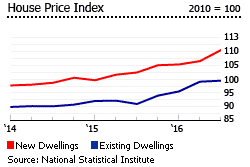
All Bulgaria’s major cities saw rising house prices.
- Sofia, Bulgaria’s capital, saw the biggest house price rise of 14.4% during the year to Q3 2016. Prices for new dwellings rose by 10.5% while existing dwellings saw a price increase of 16.2%.
- In Stara Zagora, overall house prices climbed 9.5% y-o-y in Q3 2016. New dwelling prices skyrocketed by 24.2% while existing dwelling prices rose modestly by 5%.
- In Plovdiv, overall house prices rose by 8.1% y-o-y in Q3 2016. Prices of existing dwellings soared by 11.6% while new dwelling prices rose by just 1.6%.
- In Varna, overall house prices rose by 5.9% during the year to Q3 2016. Over the same period, prices of existing dwellings increased 6.6% while new dwellings rose 4.5%.
- In Ruse, overall house prices rose by 5% during the year to Q3 2016. New dwelling prices increased 5.5% while existing dwelling prices rose by 4.8%.
- In Burgas, overall house prices increased 4.6% during the year to Q3 2016. New dwelling prices rose by 6.6% while existing dwelling prices increased by a meager 1.3%.
Transactions up too
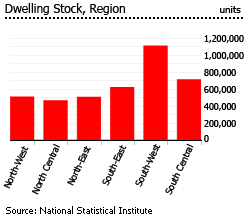
In the third quarter of 2016, completed deals in Sofia rose by 9.5% from a year earlier, according to Bulgarian Properties.
“Sofia is leader in sales, but it should be pointed out that in Plovdiv, Varna, Burgas and Stara Zagora trends are positive too with sales growth reaching between 5% and 10%,” said Stoykova.
Investors are looking for investments that provide capital gains and rental returns. Holiday homes are now considered attractive as rental income investments. Most properties are purchased for cash.
“There is a trend of high demand for holiday homes,” Stoykova added. “Currently, about half the purchases of vacation homes at the seaside and in ski resorts are made by Bulgarians. Before, this market used to be mainly dominated by foreigners.”
The average number of days on the market before a residential property is sold stood at 63 days in 2015, sharply down from 104 days in 2014, 97 days in 2013, and 121 days in 2012, according to Bulgarian Properties.
Most sought-after locations
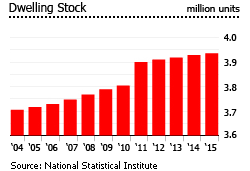
Sofia’s Southern districtsare the most preferred location. In Lozenets and the city center, demand remains high despite that fact that these locations have the highest property prices in the country, ranging from €1,200 to €1,500 per sq. m. Overall, the average price of sold apartments in Sofia stood at €930 per sq. m. in Q3 2016, up 3.3% from the previous quarter.
The Hladilnika and Krastova vada districts, particularly along the Cherni Vrah Boulevard and around the Paradise Center shopping mall, are also popularbecause of their amenities, trade centres, improved infrastructure, proximity to Vitosha Mountain and the future opening of metro stations.
Other districts in demand include Studentski grad and Vitosha because of the availability of newly-built homes at affordable prices. The average price of dwellings in these locations was €730 per sq. m. Mladost districtis also popular.
The cheapest apartments were in the districts of Druzhba, Suhata reka, and Levski, at an average price of €580 per sq. m.
Construction still way below peak, and falling
From 2005 to 2011, 16,700 dwelling units were completed every year. Construction peaked in 2009 when dwellings completed exceeded 22,000 units. However, completions fell sharply to an average of 9,700 units from 2012 to 2014 and in 2015 completions were down to 8,137 units, according to the National Statistical Institute (NSI).
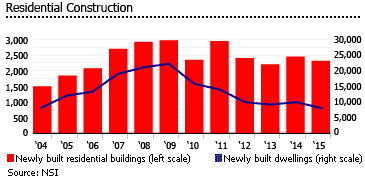
Two- and three-bedroom dwellings represent about 32.7% and 33.3% of the total dwelling stock in Bulgaria.
Interest rates continue to fall

Interest rates in Bulgaria continue to decline. The average mortgage interest rate for BGN-denominate loans fell to a record low of 4.56% in November 2016, from 6.34% in November 2014, according to the Bulgarian National Bank.
For BGN-denominated loans, in November 2016:
- Interest rate fixation (IRF) of up to 1 year: 4.56%, down from 6.34% two years earlier
- IRF over 1 and up to 5 years: 3.85%, down from 6.28% two years ago
- IRF over 5 and up to 10 years: 5.34%, down from 6.59% two years ago
- IRF over 10 years: 4.43%, down from 6.58% two years ago
Likewise, for Euro-denominated loans:
- IRF of up to 1 year: 5.08%, down from 6.8% two years ago
- IRF over 1 and up to 5 years: 4.9%, down from 7.22% two years earlier
- IRF over 5 and up to 10 years: 6.37%, up from 5.67% two years ago
- IRF over 10 years: 5.16%, down from 6.14% two years ago
Small mortgage market
Bulgaria’s mortgage market has been declining in recent years, from 12.11% of GDP in 2010 to 10.43% of GDP in 2015. But this came after massive expansion during the boom years from just 0.38% of GDP in 2000.
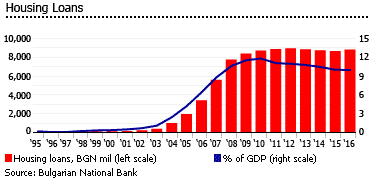
This expansion may soon resume. There were BGN231.6 million (€118.3 million) new housing loans in November 2016, up 46% from the same period last year. About 89% of the new housing loans are BGN-denominated loans, with IRF of up to 1 year.
Rental yields are rising
Sofia has moderate to good gross rental yields - i.e., the rental return on a property if fully rented out, before all expenses. Yields in the centre were around 6% in August 2016, up from about 4.7% to 5.7% in the same period last year, based on recent Global Property Guide research. Yields in the suburbs are also moderately good, ranging between 5% and 6.5% over the same period.
Doctor’s Garden, Ivan Vazov, Iztok and Lozenets are among the most sought after addresses in the centre. Embassies, museums and universities are located here. These areas also have many parks and green spaces, making them popular with expats.
In the southern part of Sofia in Vitosha Mountain (or in the vicinity) are prestigious suburban neighborhoods like Boyana and Dragalevtsi.
The Global Property Guide was not able to provide yields in Bulgaria’s beach and ski areas, because rents in these areas are highly seasonal.
Transaction costs in Bulgaria are moderate, and more or less evenly split between buyer and seller.
Economic growth, budget surplus
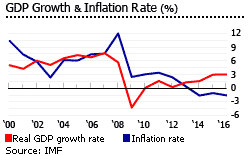
The economy is expected to expand by 2.8% in 2017, according to the IMF - one of the fastest growth rates in the European Union. In Q3 2016, Bulgaria’s economy grew by 3.4% from a year earlier, according to the NSI, and grew by 3% in 2015, an improvement from annual growth rates of 1.5% in 2014, 1.3% in 2013, and 0.2% in 2012, according to the International Monetary Fund (IMF).
The budget surplus was 1.6% of GDP this year, the country’s first budget surplus since 2008. In 2015, the country’s consolidated budget deficit fell to 2.9% of GDP, down from 3.7% of GDP in 2014.
Deflation of 1.6% is expected this year.
Unemployment stood at 7.9% in November 2016, down from 9.9% a year earlier, according to the NSI. Unemployment is expected to be 7.1% in 2017, according to the European Commission.